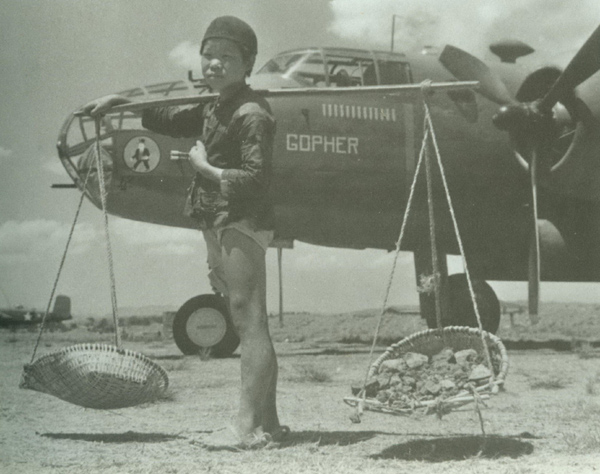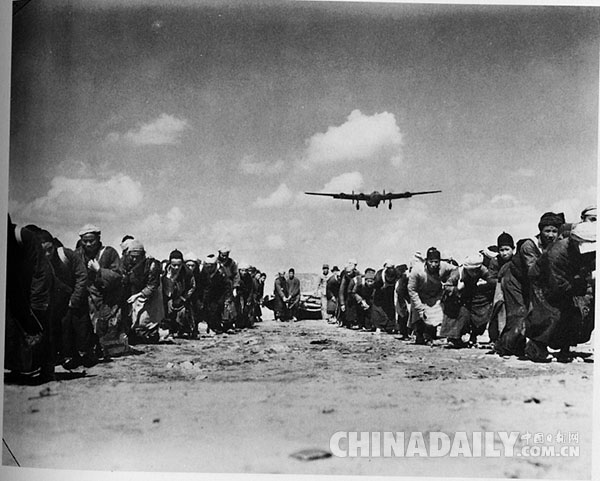Hundreds of thousands toiled day and night to construct four air bases for US military
 |
|
A teenager carries materials used for building a military airstrip near Chengdu for the US air force during World War II. China Daily |
Visitors to the Jianchuan Museum Cluster in Dayi county in Sichuan province show a keen interest in five huge stone rollers on display in the largest private museum in China.
Weighing from five to 15 metric tons, they have been rated as first-class cultural relics by the National Administration of Cultural Heritage, thanks to their role during World War II.
To Liu Chaoxu, the rollers meant a trip down memory lane to more than 70 years ago when around 500,000 people near Chengdu, the capital of Sichuan, worked day and night to build landing strips for the United States air force.
"In late 1943, when I was 16, I walked for one day with fellow villagers to Xinjin county to build a military air base for Americans for nearly six months. There were no machines, and we used a roller to flatten the runway," said Liu, a farmer in Pixian county in Sichuan.
In I943, the Allies decided to deploy B-29 bombers in India that would refuel near Chengdu before bombing targets on the Japanese mainland.
To implement the plan, the Nationalist government mobilized 500,000 people near Chengdu to build four military air bases in Xinjin, Qionglai, Guanghan and Pengshan counties from late 1943 to May 1944.
"Men, women and teenagers joined in the project. All of us worked day and night," Liu said.
To build a runway, workers had to clear away soft topsoil and dig about 1.5 meters below it until they reached the hard soil.
"We covered the hard soil with cobblestones and filled the gap between the cobblestones with broken cobblestones and slurry," said Liao Nanshan, a 96-year-old farmer in Dayi who joined in the construction of the air base in Qionglai.
After that, more than 100 workers worked together to pull a stone grinder to flatten the surface.
"It did not mean a runway was finished when the surface was flattened. We had to cover the cobblestones on the surface and fill the gap between the cobblestones with broken cobblestones and slurry again before we used a stone roller to flatten the new surface. The process was repeated three or four times before the final surface was called a runway," Liao said.
The US forces marveled at how Chinese workers relied on their hands and stone rollers to finish four air bases within six months. A veteran wrote that the only modern tool he found at the construction sites was an electric lamp because workers had to race against time and worked at night.
Workers had heartbreaking memories of stone rollers crushing fellow workers to death because so many people pulled them at the same time, said Yu Xuntan, a writer in Chengdu.
Since labor was in short supply, Yu, a high school student from Jintang county in Sichuan, worked at the airstrip construction site in Guanghan with some 100 fellow students for one week in 1944 when he was 13.
By the end of 1944, 250 US planes, more than 100 of which were B-29 bombers, had landed at the four air bases near Chengdu.
Taking off from the four bases, more than 70 B-29 bombers struck Yawata, a steel-producing base in Japan, in June 1944. Later, B-29 bombers hit the Japanese mainland and Japanese-occupied areas in China many times.
During her visit on Monday to Dujiangyan, Sichuan, Nell Calloway, director of the Chennault Aviation and Military Museum in Louisiana in the US, said: "Without the airports, the war might have been different, for Japan had so many warplanes. In fact, the war might have been lost."
Tan Jihe, president of the Sichuan Provincial Association of History, added: "Because of the B-29 bombers, Japanese planes did not dare to bomb Sichuan arbitrarily."
Chengdu underwent 31 bombing attacks, from 1938 to 1944. The dead and injured numbered 5,337, according to the Chengdu Civil Air Defense Office.
 |
|
Chinese laborers grind a runway by dragging stone-rollers on towropes. [Photo exclusively provided to chinadaily.com.cn] |
Chinese laborers risk lives building airports for Allies
The Chinese people built and maintained dozens of airports during World War II, providing for a massive airlift of fuel and supplies for Allied forces and serving as a crucial base to oppose Japanese aerial bombardments in the Asia-Pacific region.
The government mobilized vast numbers of civilians and material resources, spending big to build air force bases across southern and southwestern China, including Chengdu in Sichuan province, Kunming in Yunnan province, and Liuzhou and Guilin in the Guangxi Zhuang autonomous region.
Sichuan's civilians incurred heavy losses and casualties in building the airfields as they were created through manpower with simple and crude tools such as stone-rollers, shoulder poles and towropes. Many workers were crushed to death when grinding the airfield runway. More